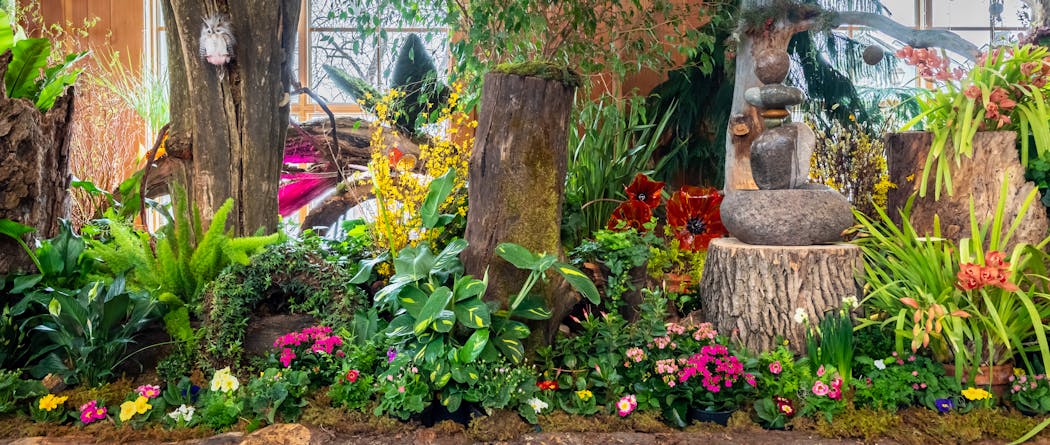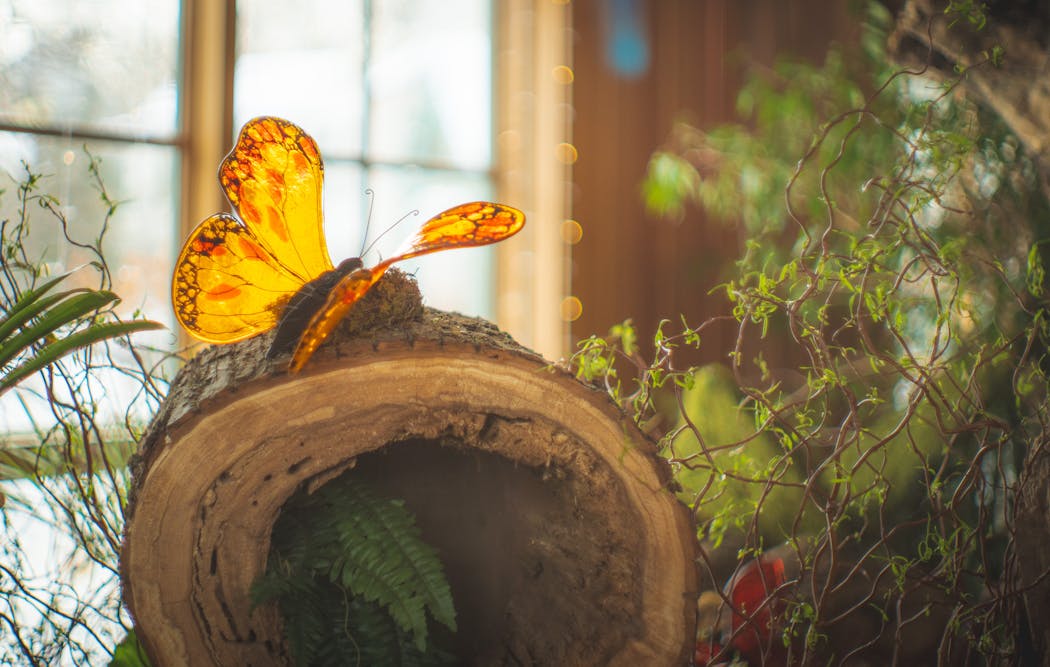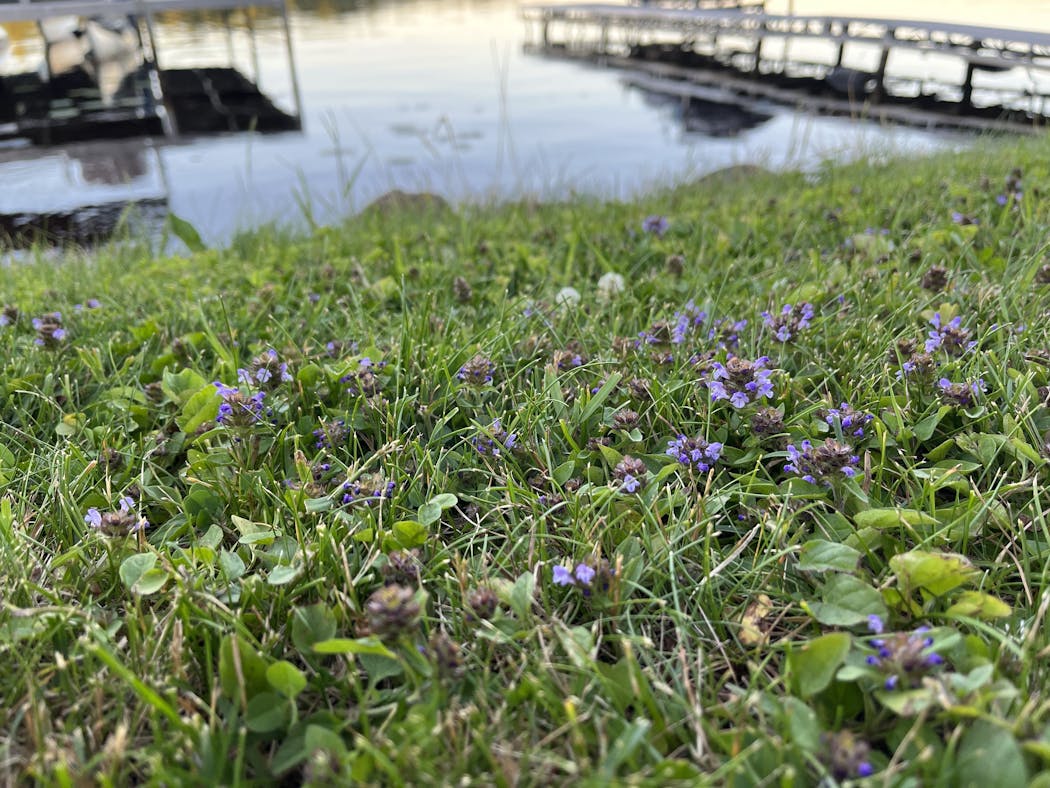Stumped on what a stumpery means? How about flawn? And what's with the "nativar" sections popping up in plant stores?
Our landscapes are constantly evolving and so are the words we use to talk about them. We asked some local lawn and garden experts to help us learn the latest lingo. Read on and get in the grow.
Stumpery
The repurposing craze has crossed over into gardening with downed wood. Stumperies — a garden feature using rotting wood that decomposes into nutrient-rich soil — are having a moment in the sun as vessels for plant arrangements.
Alan Branhagen, director of operations at the Minnesota Landscape Arboretum, said stumperies date back to 1850s England, when gardener Edward William Cooke began using them in his designs. The trend is making a comeback with an environmental angle.
"It was popular back then because they were so into ferns and these tree stumps created a great habitat for these kinds of plants," Branhagen said. "Now with the environmental movement, they're having some additional value because some of our native species like bees and moths like to burrow into this fallen wood. It's all of a sudden become an important component of nature."
For those looking to incorporate a stumpery into their garden, Branhagen recommends starting with moss, ferns, miniature hostas or wildflowers (such as hepatica), which grow well in woodland environments.
"They like organic-rich soils and are shade-loving," said Branhagen, who noted that the arboretum recently featured a display on stumperies and a more permanent installation is in the works.
Start with a stump or logs from dead trees that have been cut down. To prep a stump for planting, use an existing hole where the wood has already rotted, or carve out a hole to the desired planting depth. You can add soil if the wood hasn't broken down enough to create its own planting medium.
Because the soil can dry out, especially during a hot spell, water as needed. And since you're dealing with rotting wood that can attract insects, be mindful of where you place a stumpery.
"You certainly don't want a stumpery next to your house," Branhagen said.
Source your dead wood responsibly, from dead trees on your property or tree removal companies. Don't remove logs or stumps from private property or parks without permission.
"We don't want people pilfering natural stumps and logs from native woodlands," he said. "But there are cases where something falls and needs to be removed. Trees get uprooted and these things happen, so why don't we recycle and make good use of it?"
Nativar
Native plants occur naturally in the wild. Cultivars are plants that are produced by selective breeding. Nativars are cultivars (bred plants) that are derived from native plants.
Navitars are typically bred for a specific trait — such as a long bloom time or compact growth habit. And some gardeners say they do particularly well in backyard environments. As a result, more garden centers are stocking their shelves with them.
"Nativars are important because some native species just aren't right in the home landscape because they're intended as a bog in nature and, if you pull it out of that environment, it can't replicate what's in nature," said Ryan McEnaney of Bailey Nurseries. "There might have been a selection in nature that was a natural mutation or maybe some breeding work was done within the species that are more disease-resistant. And it takes that species and its ecological and pollinator benefits into the home landscape."
Some native plant proponents say nativars could diminish the popularity of native plants, which are naturally adapted to a specific region.
When buying a nativar, McEnaney said, it's important to check to make sure it can thrive in the upper Midwest (USDA Zone 4).
"It goes back to that regional piece to ensure whether you have success," he said.
Flawn
Like Brangelina and TomKat, some couplings of words just weren't meant to last. In the gardening world, time will tell if "flawn" will survive.
A flawn is a term for a bee-friendly, flowering lawn that a family-run operation in Eau Claire, Wis. has patented and trademarked for its seed kits. The company, called Flowering Lawn, was launched in February 2022 with plans to sell its flawn kits in Twin Cities stores in the coming months.
For owner Anthony Nied, the concept made sense as a natural extension of his organic lawn care service. He said entering the Twin Cities market has special meaning to him since the University of Minnesota's research is credited for the rise of bee lawns.
"We hope to create more natural solutions and it's a step in the right direction," Nied said.
From 2016 to 2019, James Wolfin was part of the University of Minnesota research group spearheaded by Marla Spivak and Eric Watkins.
These days, "You'd be hard-pressed to find a garden center in the Twin Cities that doesn't carry a bee lawn mix," Wolfin said. "The more we see these conservation-friendly, pollinator-friendly lawn alternatives start to gain traction, the more the merrier."
Wolfin now works as a bee lawn expert at Twin City Seed Co. to support the growing interest in incorporating forage- and nest-friendly, low-growing flowers and/or grasses into yards. Bee lawns are also getting a buzz for having a lower environmental impact than traditional turf lawns.
"These are what are called low-input lawns, that require less watering, less fertilizing and less mowing," he said. "And they also provide the opportunity for recreational gathering and play."
Popular perennial mixes — which can include Dutch white clover, creeping thyme, self-heal, yaak yarrow and narrow-leaf blue-eyed grass — can be seeded over existing grass. These seed mixes are designed to establish themselves over time.
"We specifically tried to stay away from flowers that are on the more aggressive side, dandelions as an example, that bees are also attracted to," Wolfin said. "We don't want this bee lawn movement to turn into neighbor wars."
If you're considering a flawn, Nied said, letting your neighbors know is a good idea.
"The friendly neighborly thing to do is walk over and converse with your neighbor before you do this. And if you have lawn-to-lawn borders and your neighbor doesn't want this going into their yard, leave a buffer strip and don't plant right up to the border," he said. And if your neighbor has a lawn care service, it could kill those plants in your lawn, so that's for the safety and health of your plants, too."

The 5 best things our food writers ate this week

A Minnesota field guide to snow shovels: Which one's best?

Summer Camp Guide: Find your best ones here

Lowertown St. Paul losing another restaurant as Dark Horse announces closing






